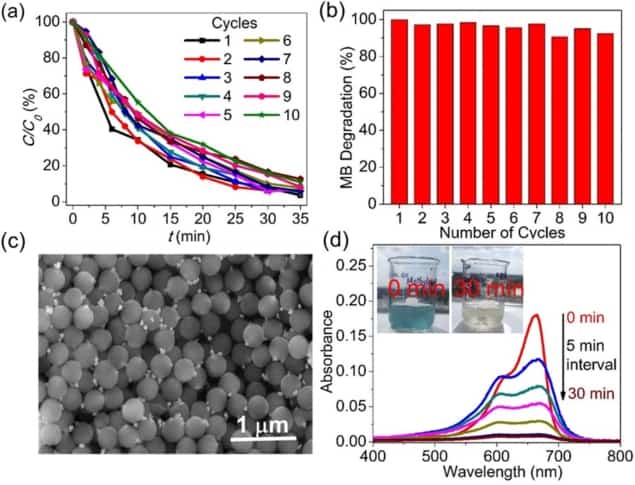
Nanoparticles are ideal for use within solar energy devices because they have large surface areas and small volumes. Silver-doped silver halide particles also display sensitized optical properties thus making them ideal for photocatalysis, but they are prone to aggregating in light. Now Yugang Sun and co-workers at Temple University in the United States have discovered that adding silica helper nanoparticles to nanoparticle catalysts dramatically improves both catalyst activity and particle stability.
Despite recent technological breakthroughs that continue to unveil new and interesting nanomaterials, an ideal photocatalyst for renewable energy efforts has not been developed. An optimal catalyst should: absorb an appropriate range of light via sensitized bandgaps, exhibit solution stability, and be both robust and active. Silver-doped silver halides (AgX(Ag)) show impressive bandgap tunability. However, few research groups have considered these particles for photocatalysis due to their colloidal instability.
Sun et al. synthesized the helper silica nanoparticle spheres using a Stöber sol-gel method. By electrostatically affixing AgX(Ag) nanocubes to these significantly larger nanoparticles, the colloidal stability of the modified-AgX(Ag) dramatically improved, meaning particles no longer immediately aggregated. Additionally, silica nanoparticles can support resonant light scattering, which improved nanocube photo-absorption within the hybrid structure. Impressively, Sun et al. demonstrate a loss of only 9% effectiveness in the heterostructure catalytic activity after 10 repeated operation cycles using ideal dye methylene blue.
A fine-tuned bandgap and an effective helper
These nano-heterostructures owe their catalytic effectiveness to the optimized bandgaps of AgX(Ag) and to the large surface area to particle volume ratio of the hybrid particle. The addition of doped Ag0 to AgX introduces multiple energy levels between the conduction and valence bandgaps of AgX thus promoting visible light absorption, an important criterion when considering solar energy developments.
In addition to preventing aggregation in solution, the silica helper particles also increase the photocatalytic activity of the AgX(Ag) nanocubes. The silica spheres produce resonant light scattering, which increases the amount of light absorbed by the doped nanocubes thus promoting electron excitation and catalytic activity. Additionally, silica’s inertness prevents charge transfer at the silica-AgX(Ag) junction.
Sun et al. note that these results directly display the criticalness of the helper silica particles in photocatalysis. Such a result paves the way for effective solar energy developments.
Full details are reported in Nano Futures.



